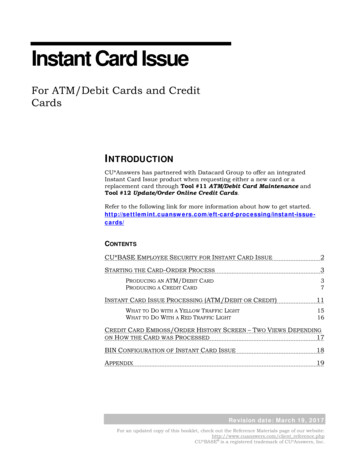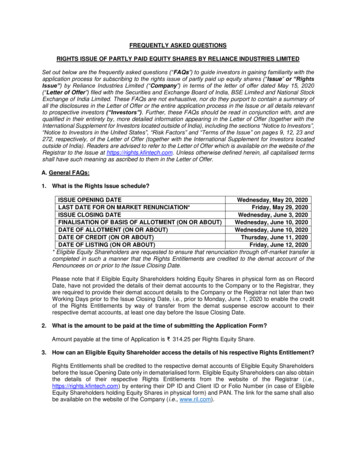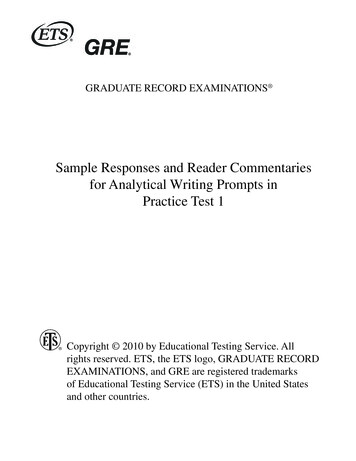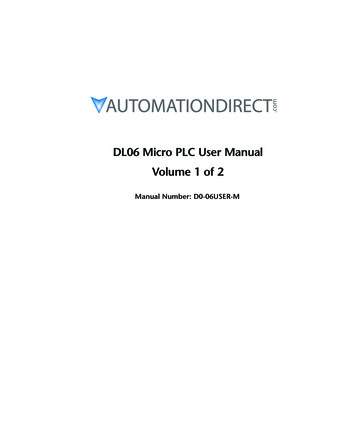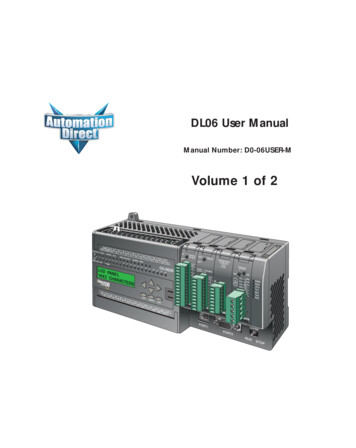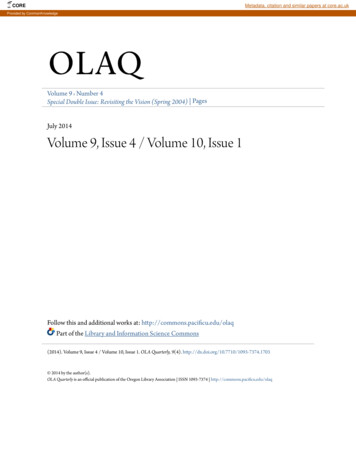
Transcription
COREMetadata, citation and similar papers at core.ac.ukProvided by CommonKnowledgeVolume 9 , Number 4Special Double Issue: Revisiting the Vision (Spring 2004) PagesJuly 2014Volume 9, Issue 4 / Volume 10, Issue 1Follow this and additional works at: http://commons.pacificu.edu/olaqPart of the Library and Information Science Commons(2014). Volume 9, Issue 4 / Volume 10, Issue 1. OLA Quarterly, 9(4). http://dx.doi.org/10.7710/1093-7374.1703 2014 by the author(s).OLA Quarterly is an official publication of the Oregon Library Association ISSN 1093-7374 http://commons.pacificu.edu/olaq
OLA Quar terlyRevisiting the VisionIn This IssueRevising the Vision Recasting Our GoalsVisions of Statewide Document DeliveryProgress Along the Road to Statewide Database LicensingStatewide Virtual Reference: a Second Call to ActionVision %&%: Serve Every ChildThe Face of Oregon’s Library CommunityThe View from a Cozy Library on the Coast of OregonOLAQSpring %%,Vol - No , / Vol &% No &
Oregon Library Associationhttp://www.olaweb.orgISSN 1093-7374OLA QuarterlySpring 2004Vol 9 No 4 / Vol 10 No 1The OLA Quarterly is anofficial publication of theOregon Library Association.Please refer questionsand input regardingthe Quarterly to:Alex RolfeOLA Publications ChairGeorge Fox University416 N Meridian StreetNewberg, OR 97132503.554.2414arolfe@georgefox.eduGraphic Production:Tobias Weiss Design7345 SW Deerhaven DriveCorvallis, OR 97333phone 541-738-1897fax uesRevisiting the VisionTable of Contents &,Call to Action:Vision 2010 CommitteeStatewide Virtual Reference:a Second Call to ActionRuth Vondracek,Revising the Vision,Recasting Our GoalsCindy Gibbon1Statewide Catalog:2004 Status ReportPam Horan2Visions of StatewideDocument DeliveryPaula Hamilton&1High Bandwidth,Affordable AccessPam Horan&2Vision 2010:Serve Every ChildAngela Reynolds %Serving Every ChildJim Scheppke&% Progress Along the Roadto Statewide Database LicensingJohn F. HelmerThe Face of Oregon’sLibrary CommunityJanet Webster and Maureen Cole& 1What’s Next for StatewideDigital ReferenceCaleb Tucker-RaymondThe View from a Cozy Libraryon the Coast of OregonWyma Jane RogersSummer 2004Local AdvocacyFall 2004TBAOLA Quarterly is indexed in Library Literature.
Oregon Library Association2003–2004 Executive BoardPresidentOEMA RepresentativeOregon Young Adult NetworkFaye ChadwellUniversity of Oregon541.346.1819chadwelf@uoregon.eduMartha DecherdDavid Douglas High School503.261.8357martha decherd@ddouglas.k12.or.usCarol ReichHillsboro Public Library503.615.6505carolr@ci.hillsboro.or.usVice President/President-electALA RepresentativePublic Library DivisionMelanie LightbodyJefferson County Library a RogersNewport Public Library541.265.2153wyma@newportlibrary.orgTeresa LandersCorvallis-Benton County Public usPast PresidentPNLA RepresentativeSupport Staff DivisionConnie BennettEugene Public sCarol ReichHillsboro Public Library503.615.6514carolr@ci.hillsboro.or.usSonja PatzerPortland State yState LibrarianTrustees and Friends DivisionColleen BellUniversity of Oregon Libraries541.346.1817cbell@uoregon.eduJim ScheppkeOregon State ary McGreerJefferson County Library Academic Library DivisionMember at LargeSuzanne SagerPortland State University503.725.8169sagers@pdx.eduSarah BeasleyPortland State University503.725.3688beasleys@pdx.eduDale VidmarSouthern Oregon nChildren’s Services DivisionEd HouseBeaverton City Library503.526.3705ehouse@ci.beaverton.or.usDebra BogartSpringfield Public Library541.726.2243dbogart@ci.springfield.or.usThe Publications CommitteeAlex Rolfe, chairGeorge Fox UniversityTorie ScottPortland Community CollegePaul FrantzUniversity of OregonStephanie MichelUniversity of PortlandKris KernPortland State UniversityMary Ellen Kenreich, ex officioPortland State UniversityAd CoordinatorRachel Mendez, ex officioPacific Northwest College of ArtEditor, OLA Web Editor
OLA Quarterly Publication Schedule 2004The OLA Quarterly is an official publication of the Oregon Library Association. Beginning with volume 3,number 4 the Quarterly is indexed in Library Literature. Each issue of the OLA Quarterly is developed bya guest editor(s), on a topic decided by the Publications Committee. To suggest future topics for theQuarterly, or to volunteer/nominate a Guest Editor, please click on the appropriate e-mail link.Vol./No.ThemeDeadlinePub. DateGuest EditorVol 10 No 2Summer 2004Local AdvocacyApril 15, 2004June 15, 2004Melanie LightbodyJefferson County Library DistrictOregon Library AssociationP.O. Box 2042Salem, OR 97308-2042Non-ProfitOrganizationU.S. PostagePAIDPermit No. 121Salem, OR
Revisiting the VisionIbecame curious last summer as Ilabored to implement elementsof the Statewide DatabaseLicensing Program. I knew that theimpetus for this new State Libraryprogram and several others supportedby LSTA funds had been OLA’s Vision2010. I started to wonder whatprogress had been made toward eachof the “Call to Action” challengesarticulated by the Vision 2010 Committee (see OLA Quarterly Fall 2001,No. 3, p. 21; ml).Are those goals being met?, Iwondered. Are they still relevant?Have important new challengesemerged? Because recent programssupported with State Library staffand/or funding are a direct outcomeof Vision 2010, my interest has beenmore than academic.Although only a few years haveelapsed since the 2010 goals were set,I thought it would be both interestingand instructive to look at ourprogress, and that perhaps an articlein OLA Quarterly might be a goodopportunity to reflect on the librarycommunity’s accomplishments as wellas the need for additional work. Inthe way of so many things, my ideaof “writing an article” quickly expanded to editing an issue.Vision 2010 began in 1999, whenthe OLA Executive Board charged theVision 2010 Committee to develop aroad map for the next decade. Thecommittee took a “rational strategicapproach to the planning process,”conducting environmental scans toprovide context, considering population, economy, and technology. Thecommittee also looked at such issuesas recruitment, and the politicalclimate affecting information resourcesand infrastructure in libraries. However, members of the committee soonrecognized that their real challengewas to describe how libraries musttransform to become successful in acompetitive environment.The Vision 2010 Committeedecided to focus on “a few giant steps”that promised to result in substantialprogress in a few key areas, to helplibraries remain at the “center ofcommunities and campuses as primaryproviders of information services.” TheOLA Quarterly’s Vision 2010 issueincluded several thought provokingscenarios of our future, intended to stirthe library community to pursue andachieve relevance and excellence inour rapidly changing world. I recommend that you re-read the issue andencourage you to participate inestablishing the infrastructure andservices that libraries require as wemove toward the future.The world around us hascontinued to change rapidly, andlibraries with it. The environment inOregon and our world is quitedifferent than it was four years ago.Economic and political aspects havebeen transformed—and both arenow significantly more challengingfor libraries.In Revisiting Vision 2010, ourauthor-contributors will address theprogress we have made toward Vision2010. Some were members of theoriginal Committee, others have beeninstrumental in forwarding someaspect of the “Call to Action” goals,including members of the SenateInterim Task Force on Library Cooperation. Each has a unique andinformed perspective. This issue’scontributors variously address thegoals of the “Call to Action,” orprovide their reflections and opinionsabout the progress we’ve made andwhat we have left to do.I offer my heartfelt thanks to ourexcellent librarians and colleagueswhose contributions you are about toread. I have learned much from theirperceptions and observations.I hope that the progress andchallenges recounted in this issue willinspire you to momentarily leave yourday-to-day tasks and step into thefuture of library service in Oregon. Itis your support and participation thatwill enable the library community tofulfill the challenges of Vision 2010.—Pam HoranOregon State LibraryGuest EditorOLAQ1
Call to Action:Vision 2010 CommitteeThe Call to Actionoriginally appeared inthe OLA Quarterly Fall2001 issueThe Vision 2010 Committee stated that thecitizens of Oregon are “best served iflibraries remain at the center of ourcommunities and campuses as primaryproviders of information services.” TheCommittee proposed a “Call to Action” thatwould result in substantial progress in afew key areas, and that would answerthree risks: inertia, adopting too broad aplan, and that libraries’ valuable resourcesmight be underused. If these risks are notaddressed our opportunity to continue toserve the needs of our citizens will be lost.The Vision 2010 Committee challenged usto “take creative steps to maximize the useof our collections and services.”E–Reference Services Create a collaborative on–line reference service that is available 24 hoursa day, 7 days a week.Statewide Library Card Sweep away regional, jurisdictionaland procedural boundaries so everyOregonian has a library card thatworks at any publicly supportedlibrary.Strong and Diverse Workforce Bring the highest caliber of leadershipto every Oregon library.Statewide Library Catalog Make the holdings of all Oregonlibraries accessible through onecatalog. Encourage Oregonians to place interlibrary loans through the statewidecatalog. Deliver library materials and information directly to the customer.Statewide Access to ElectronicResources Secure a broad and deep menu ofstate–funded electronic databases thatare available to all libraries and librarycustomers in Oregon.2Statewide High Speed Network Ensure that every library has easy andaffordable access to a high quality,high bandwidth telecommunicationsnetwork.Serve Every Child Nurture the joy of reading by providingevery child in Oregon with qualitylibrary services from both public andschool libraries. Use the broadest range of skills andabilities from people with diverseeducational, experiential, and culturalbackgrounds.—Illustration by—Robin Speer2004
Thompson Gale Ad to go herefile name: GAD07404 OregonLib.pdf3
Revising the Vision,Recasting Our Goalsby Cindy GibbonSenior Library ManagerMultnomah County LibraryPast ChairOLA Public Library DivisionStatewide Library Card Sweep away regional, jurisdictionaland procedural boundaries so everyOregonian has a library card thatworks at any publicly supported libraryStatewide Library Catalog Make the holdings of all Oregonlibraries accessible through onecatalog.4Vision 2010 is a bold call to actionfor the Oregon library community.We’ve already made significant progresstoward several of our goals. For example,we’ve agreed to divert Library Services andTechnology Act (LSTA) funds from netlender reimbursement to the statewidedatabase licensing program. Even in ruralareas of Oregon most libraries now haveaccess to high bandwidth telecommunications. Our pilot e-reference service is upand running. We owe our progress towardthese goals to our level of commitment. Abroad cross section of OLA members andthe library community at large agreedthese were high priorities for enhancingservice to library users.Significantly, the top two goals ofVision 2010—the Statewide Library Cardand Statewide Library Catalog—haven’tseen much progress. Why? Evidence fromforums conducted around the state inSpring 2002 by the Public Library Division(PLD) Executive Board indicates we oweour lack of progress toward these goals toour lack of commitment. We must reexamine these two goals, because we reallyaren’t collectively sure that either goal isworthy of our efforts.During the months of February andMarch, 2002, the PLD Board conductedfive forums on the concept of a statewidelibrary card for Oregon. During the courseof those conversations, we also receivedcomments on the statewide catalog.Forums were held at the Public LibraryDirector’s meeting in St. Helens; theSouthern Oregon Library Federationmeeting at Umpqua Community College;the Eastern Oregon Library Associationmeeting at Pendleton Public Library; atHatfield Marine Sciences Center, Newport;and at Multnomah County Central Library,Portland. Based on the comments receivedat those forums, the PLD Executive Boardreported the following findings to the OLAExecutive Board on April 18, 2002.What would a statewide librarycard look like if Oregon had one?Forum participants generally agreed that: A statewide library card would allowin-person access to any public libraryin the state for any Oregon residentwho has a valid library card from anyparticipating Oregon public library. To deal with the issue of unservedareas, all participating libraries wouldagree to charge an established minimum non-resident fee to persons wholive in an area where there is no taxsupported public library service. The card would be tied to a specific setof agreed-upon services applicablethroughout the state. If the purpose of a statewide librarycard is to provide service to people inareas that have not chosen to supportlocal public library service, there mustbe state funding to support theiraccess. PLD Board did not recommendthis approach, both because of thecurrent fiscal and legislative climateand because it seems to reward thoseareas of the state that persistently resistfunding public library service.How would a statewide librarycard assist library users?Many forum participants felt that a state-
V o l N o wide library card provides little benefitwhere regional cooperative agreementsexist. Most of the benefits of a statewidelibrary card could be achieved by encouraging more regional agreements. For mostOregonians, in-person access is mostrelevant when it applies to libraries in theirown home region. My in-laws, who live inBurns and use the Harney County Library,go to Bend regularly to shop or visithealthcare providers. For them, a regionalagreement providing free access toDeschutes County Libraries might be verybeneficial. But they wouldn’t have muchuse for a library card that gave them freeaccess to Tillamook County or MultnomahCounty Libraries.Working regional agreements existamong libraries in many parts of Oregon.Identifying best practices and encouragingand assisting the development of additional meaningful regional agreementsshould be a priority for OLA in partnershipwith the Oregon State Library.Thoughts on the statewidedatabase/catalogForum participants shared these thoughtson the idea of a statewide catalog: Regional access agreements would notrequire the development of a statewide library catalog. Additional costs of providing interlibrary loan service based on a statewide catalog, including delivery costs,would require a state subsidy. A statewide database is no longer theonly option for providing greateraccess to a broader range of materials.Examples of varying degrees of accessinclude WorldCat, the expanded use ofZ39.50, products such as WebFeat, andthe efforts by automation vendors touse NCIP (National Circulation Interchange Protocol) whereby circulation/V o lN o S P R I N G information is shared between different integrated library systems.Thoughts on fundingWe heard at all the forums that jurisdictions levying taxes to provide local publiclibrary service are unwilling to subsidizeservice to unserved areas. A state subsidyof local library services would be requiredto accomplish the vision of universalaccess promised by a statewide librarycard and a statewide catalog. Forumparticipants saw little chance of theLegislature funding such a program anddid not favor use of LSTA funds for thispurpose. Some participants were willing toconsider use of LSTA monies to fund apilot project only.Participants were clear that a statewide database licensing program wastheir highest priority for use of anyavailable funds.Revising our visionBased on these conversations, it seemsclear that OLA must rethink the top twoVision 2010 priorities. The library community in Oregon is ambivalent at best aboutthe Statewide Library Card and Catalog.For many of us, these are ideas whosetime came and went in the last millennium, and we don’t believe they willnecessarily provide better library service toOregonians today. Others doubt we willever have sufficient state level resources toaccomplish either goal and believe theresources we do have are better spent onother priorities.What needs did we hope to meet forour users by establishing a statewidelibrary card and catalog? Is regional,rather than statewide, cooperation themost practical way to meet those needs?Or can we envision a creative newstrategy, with the power to capture ourcollective imagination and commitment?Let the conversation begin!5
Statewide Catalog:2004 Status Reportby Pam HoranTechnology Planning ConsultantLibrary Development ServicesOregon State LibraryStatewide Library Catalog Make the holdings of all Oregonlibraries accessible through onecatalog. Encourage Oregonians to placeinterlibrary loans through the statewide catalog. Deliver library materials and information directly to the customer.Although it appears that Oregon issome years away from offering aneffective statewide library catalogto its citizens, the infrastructure necessaryfor such a statewide service is movingslowly into place. The goal would be toallow patrons to initiate requests for anylibrary materials available in the state, andto receive them within two days—much asthe Orbis Cascade Alliance borrowingsystem works now.Figure 1 below provides a graphicrepresentation, locating most of thepublic/academic library regional sharedsystems around the state.Figure 2 on the following page gives asnapshot of Oregon’s shared systems andlarger public library systems, indicating thenumber of public and academic libraryparticipants, the population served orenrollment, the number of titles reported,and the variety of vendors used—Innovative, Epixtech iPac, Polaris, DRA, WebPac,Voyager and TLC.From the table in Figure 2 we cancalculate that roughly 13 percent ofOregon’s population is not currently in aservice area with a public shared catalog orlarge library system. Moreover, roughly 20percent (35 libraries) of Oregon’s academicand legally established public librariesneither participate in a shared catalog norare in a large library system.The development and expansion ofregional shared catalog systems that includepublic, academic and some school librarieshas had a dramatic effect on the accessibility of library materials for patrons and theease of requesting them, resulting in thegrowth of Interlibrary Loans (ILLs) throughout the state. Since 1995, the growth rate ofILLs has been consistently high, with a2002–03 increase of over 12 percent.SharedOnlineCatalogs6Figure 1by Jim Scheppke,State Library 2003
V o l N o /V o lN o S P R I N G Figure 2Although this double digit rise is impressive, it is far short of the robust growth ofthe previous three years (minimum 19percent per year), which has been duelargely to participation in shared systemsby Oregon libraries. And Oregon ranks animpressive third in the nation for ILLs(470.65 per 1,000 population), far abovethe national average of 70.46 per 1,000.Only Rhode Island and Wisconsin make abetter showing (National Center forEducation Statistics, Public Libraries in theUnited States: Fiscal Year 2001 Table. A2,p.110 at http://nces.ed.gov/pubsearch/pubsinfo.asp?pubid 2003399).A statewide catalog may be achievedmore quickly than expected if changingtechnology and reduced costs allow. Butlocal politics and political concerns mayprove more daunting challenges thanthose of cost and technology.7
Visions of StatewideDocument Deliveryby Paula HamiltonChairOLA ResourceSharing CommitteeStatewide Library Catalog Encourage Oregonians to place interlibrary loans through the statewidecatalog. Deliver library materials and information directly to the customer.How to provide document deliveryfrom any one Oregon library to anyother library within Oregon?Inspired by the futurist scenarios accompanying the Vision 2010 document, theOLA Resource Sharing Committee (RSC)decided to apply for a grant to assistlibraries to survive and thrive in the nextquarter century. Committee membersAletha Bonebrake, Gretta Siegel, Ann Fox,Mary Jane Fisher, Frances Rasmussen,Lorraine Borchers, Jeff Ring, Greg Doyle,and Paula Hamilton fixed on pushingtoward “the knife edge ridge,” describedin Deborah Carver’s article as a placeclose to the summit, where the slopesdrop off precipitously, and where, inorder to reach one’s goal, the summit, onemust focus (Carver, 2001).We decided to focus on maximizingthe use of Oregon’s library collections bydeveloping a plan to provide documentdelivery to all libraries in the state.Our committee work relates to resource sharing. The challenge for us,described in Vision 2010, falls under thecharge to establish a statewide librarycatalog. Two objectives relate directly tothe RSC:1.2.8Encourage Oregonians to place interlibrary loans through the statewidecatalog; andDeliver library materials and information directly to the customer.We realized that some libraries in thestate did not participate in the courierservice and others did not offer interlibraryborrowing because they could not afford topay document delivery costs. But we alsofound that resource sharing in Oregonthrough interlibrary loans is steadilyincreasing due to the high visibility ofresources to patrons, and the availability ofpatron-initiated borrowing. Assuming thatpatrons would be able to request materialsdirectly from a statewide catalog, a statewide delivery system is both logical andnecessary. With the goals of Vision 2010 inmind, the RSC wrote a grant proposalunder the auspices of the Oregon LibraryAssociation to the State Library to obtainLibrary Services and Technology Act (LSTA)funding. The committee sought funding todevelop a plan for an effective statewidedelivery system in Oregon.We were awarded LSTA funding and, inearly 2003, hired Wes Stevens, Facilities andOperations Supervisor for MultnomahCounty Library, as our consultant. Wesexamined existing in-state delivery systems,studied statewide plans operating in otherstates, and devised an extensive plan andmaps outlining a highly effective statewidedelivery system.Wes and the committee later met withJohn Helmer, Nancy Nathanson, and TravisHonea of the Orbis Cascade Alliance, andtogether we developed the following goals:Short term goals1.Continue to publicize (“raise awareness” about) the courier system.2.Approach selected libraries that clearlywould serve well to become a forwarding site associated with a drop site,based on proximity.
V o l N o 3.Approach selected public libraries thatwould be good candidates to formnew drop sites (based on volume,postage costs): Albany, DouglasCounty, Eugene, Hood River, andSpringfield.4.Begin a conversation with the OLABoard, the Oregon State Library, andthe LSTA Advisory Council about thepotential for subsidizing selecteddrop sites./V o lN o S P R I N G For good reading, you will find thecomplete OLA Resource Sharing Committee report, authored by Wes Stevens, onour web page: r D., 2001. The Knife Edge Ridge.OLA Quarterly 7(3):1.Longer term goals1.Continue plans to reduce courier costsfor selected sites (e.g. reduced fees forlow-volume sites and options for lessfrequent pickups) during the next RFPfor courier service, as the OrbisCascade Alliance has done in the past.2.Seek additional LSTA monies to fund alimited-duration project to helporganize libraries not currently linkedto the Orbis Cascade Alliance couriersystem.3.Subsidize courier fees for selected sites(sites, formula, and source of funds tobe identified).Using this plan as a working document, we hope to cut through the barriersto providing efficient, cost-effectivedocument delivery service to all libraries inOregon. Our intention is to request asubsequent LSTA grant to carry out thegoals stated above. With a statewidedelivery system in place, can a statewidecatalog be far behind?9
Progress Along the Road toStatewide Database Licensingby John F. HelmerExecutive DirectorOrbis Cascade AllianceStatewide Access to Electronic Resources Secure a broad and deep menu ofstate–funded electronic databases thatare available to all libraries and librarycustomers in Oregon.A10re we making progress towardachieving the Vision 2010 goal ofsecuring a “broad and deep menuof state-funded electronic databases that areavailable to all libraries and library customers in Oregon?” Perhaps. But, as with anyjourney, optimism about progress dependson knowing what you’re aiming for, whereyou are now, and whether you have thestaying power to continue the journey.Statewide database licensing in Oregondates back to 1991, with the creation ofOLA’s Vision 2000 and the resulting set ofgoals known as the Oregon InformationHighway Project (OIHP) (Scheppke, 1995).By 1995 a group of librarians was workingas the Statewide Database Licensing Group(SDLG). Deb Carver speaks of the “longand sometimes confusing process” (Carver,1999) of jump-starting statewide licensingwithout central funding or project staff.The SDLG eventually decided that seedmoney was needed to get things startedand they devised a program based ongradually declining LSTA subsidies. SDLGalso found that an administrative partnerwas needed and turned to Orbis and theOregon Educational Technology Consortium (OETC) to issue an RFP, sign purchaseagreements, bill libraries, and pay thevendor. In a remarkably short time, libraries were weaned from LSTA funds andSDLG ventured forth into a new era of selffunded purchasing.While pleased with this success, therewas also a sense among many that Oregonwas not doing enough. Although clearlyworthwhile, SDLG was purchasing just twoproducts and many libraries in the statecould not afford to participate. At the sametime, early projects in wealthy states likeMichigan, Ohio, and California wereexpanding and being joined by new statefunded efforts in places like Alabama,Tennessee, and Kentucky. Surely, theremust be a way for Oregon to keep pacewith Mississippi.As we entered the new millennium,two new visions emerged. One was Vision2010, the other came from a grassrootseffort known as Connect Oregon or CORE(Connect Oregon, 2001). Patterned afterNCLive! in North Carolina, CORE’s visioncalled for a statewide multi-type consortiumfunded by the state, LSTA, and participatinglibraries. CORE would begin with databaselicensing, then move on to other statewidepriorities. The CORE effort gatheredmomentum very quickly and OLA sponsored a bill requesting state funding. Alas,although well received, the CORE bill diedat the end of a busy legislative session.The aftermath of the CORE effort led tothe formation of the Senate Interim TaskForce on Library Cooperation. In its finalreport, the Task Force identified “statewidecoordination for purchasing databases” asthe highest priority and stated that theOregon State Library (OSL) “will becomethe host and fiscal agent for a new consortium organization charged with coordinating statewide services for Oregon libraries.”(Oregon Senate, 2002). Unfortunately, taskforce ground rules stated that no new statefunds could be sought and, after exploringvarious options, the task force concludedthat LSTA funds should be used to supplement fees and support project staff at OSL.Financial support for this new effort wouldcome at the expense of the net-lenderreimbursement program, a long-standingeffort aimed at encouraging ILL. Passage ofSenate Bill 12 enabled OSL to play thisexpanded role and in 2003 the OregonStatewide Database Licensing Program(SDLP) was born (Oregon StatewideDatabase Licensing Program, 2003).Now, as we begin 2004, the EBSCOcontract managed by SDLG in partnershipwith Orbis Cascade Alliance and OETC
V o l N o will soon come to an end. The StateLibrary and the Statewide DatabaseLicensing Advisory Committee (SDLAC)are working to define program rules anddraft a new RFP. OSL is also consideringthe extent of its role and whether enlisting the help of other organizations, suchas the Bibliographic Center for Research(BCR), OCLC Western, Orbis CascadeAlliance, or OETC might make sense.It has been a long strange trip, fromVision 2000 to OIHP to SDLG to Vision2010 to CORE to the Senate Task Forceand now SDLP, but have we madeprogress toward a “broad and deep menuof state-funded electronic databases?” Theanswer to that question depends on yourperspective. A pessimist might say that westarted with two products subsidized withLSTA funds, finally achieved self-fundingby participating libraries, and have nowdismantled the net lender program inorder to spend even more LSTA money(now on a recurring basis) to replicatepurchase of the same two products. Anoptimist might say that the net lenderprogram was no longer effective andapplaud its replacement by a robustdatabase licensing effort. The optimistwould further note that the previous SDLGprocess was risky and very limited inscope, while the new SDLP structure willhave a much broader impact.Although both have a point, I mustadmit to a strong preference for theoptimist’s view. Still in its early stages, thenew Statewide Database Licensing Program marks an ambitious role for theOregon State Library and shows muchpromise for the future. SDLP is a greatnew beginning but several factors will becritica
416 N Meridian Street Newberg, OR 97132 503.554.2414 arolfe@georgefox.edu Graphic Production: Tobias Weiss Design 7345 SW Deerhaven Drive Corvallis, OR 97333 phone 541-738-1897 fax 541-738-1897 julie@tobiasweissdesign.com . instrumental in forwarding some aspect of the "Call to Action" goals, including members of the Senate Interim Task .



